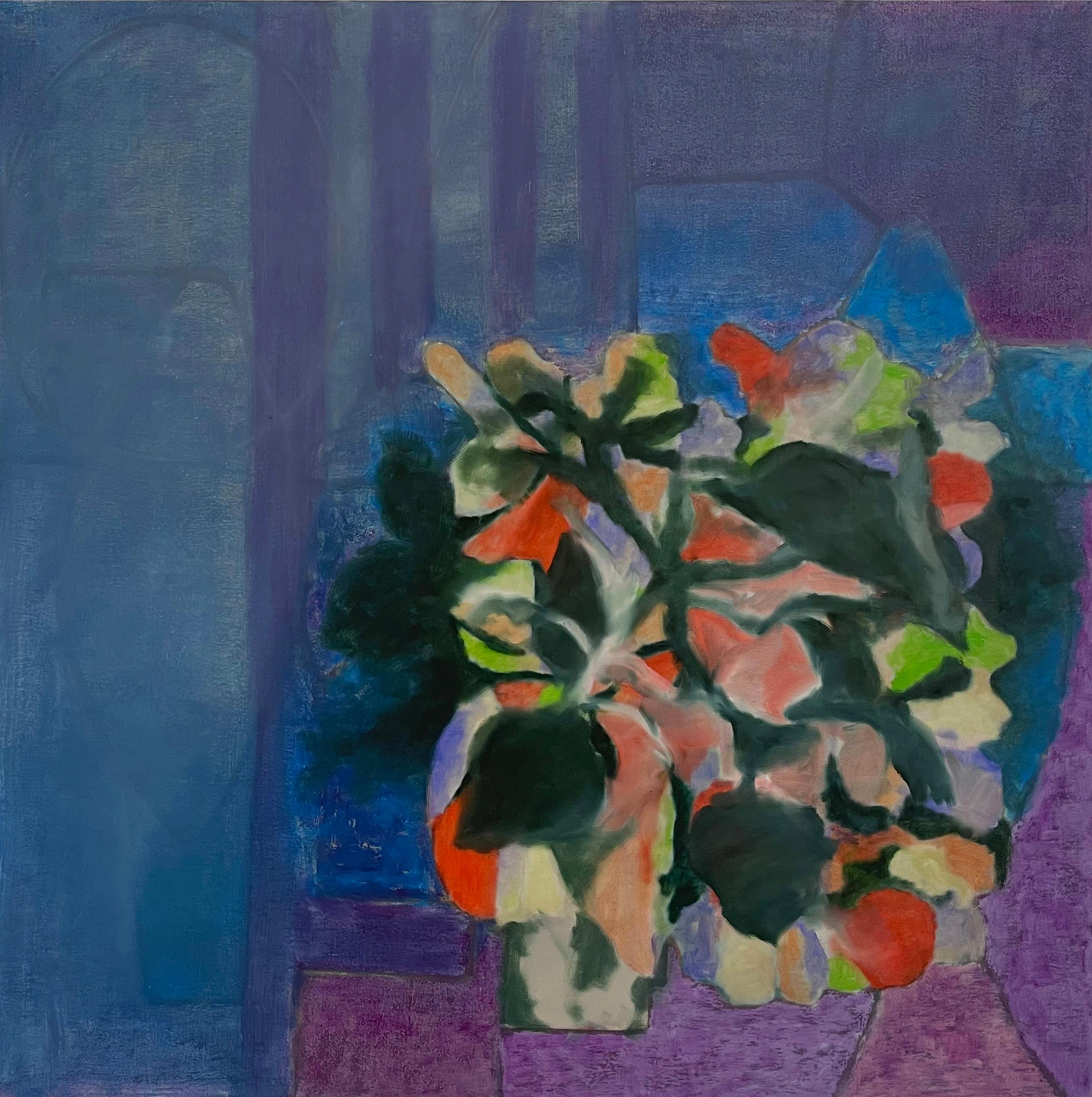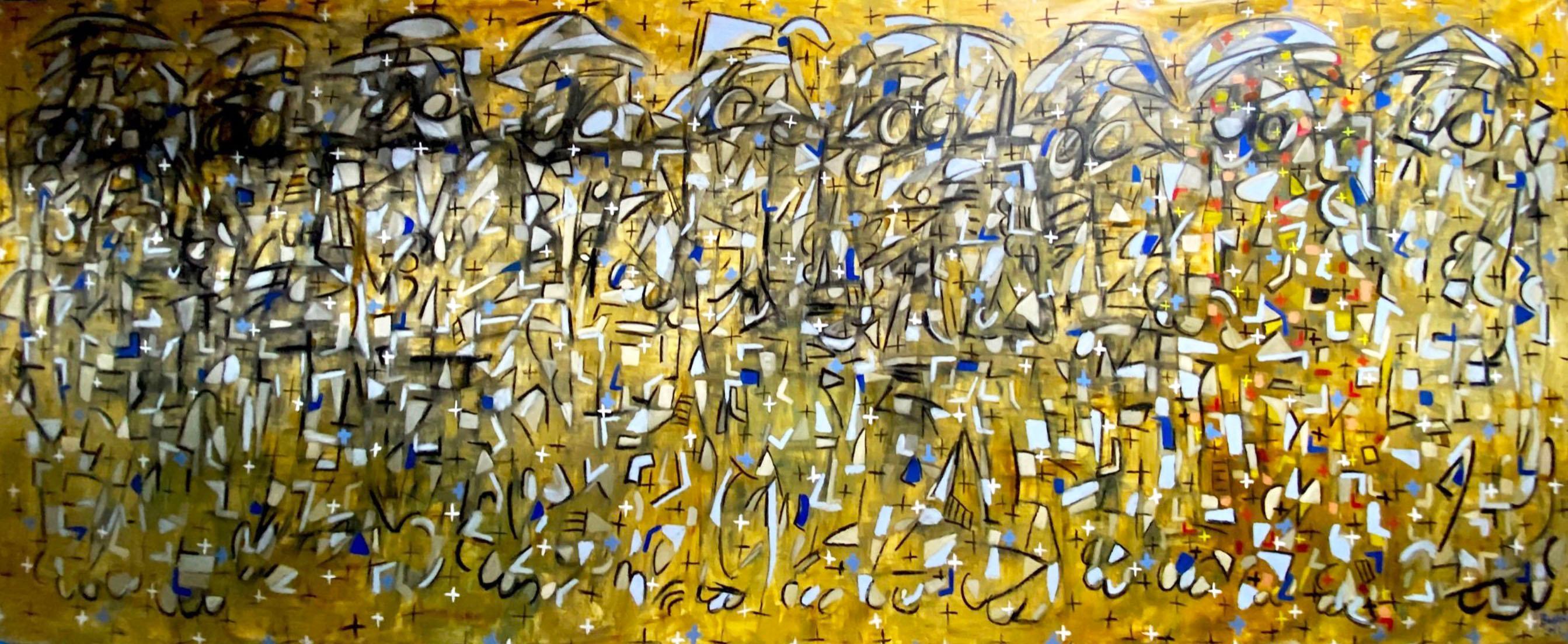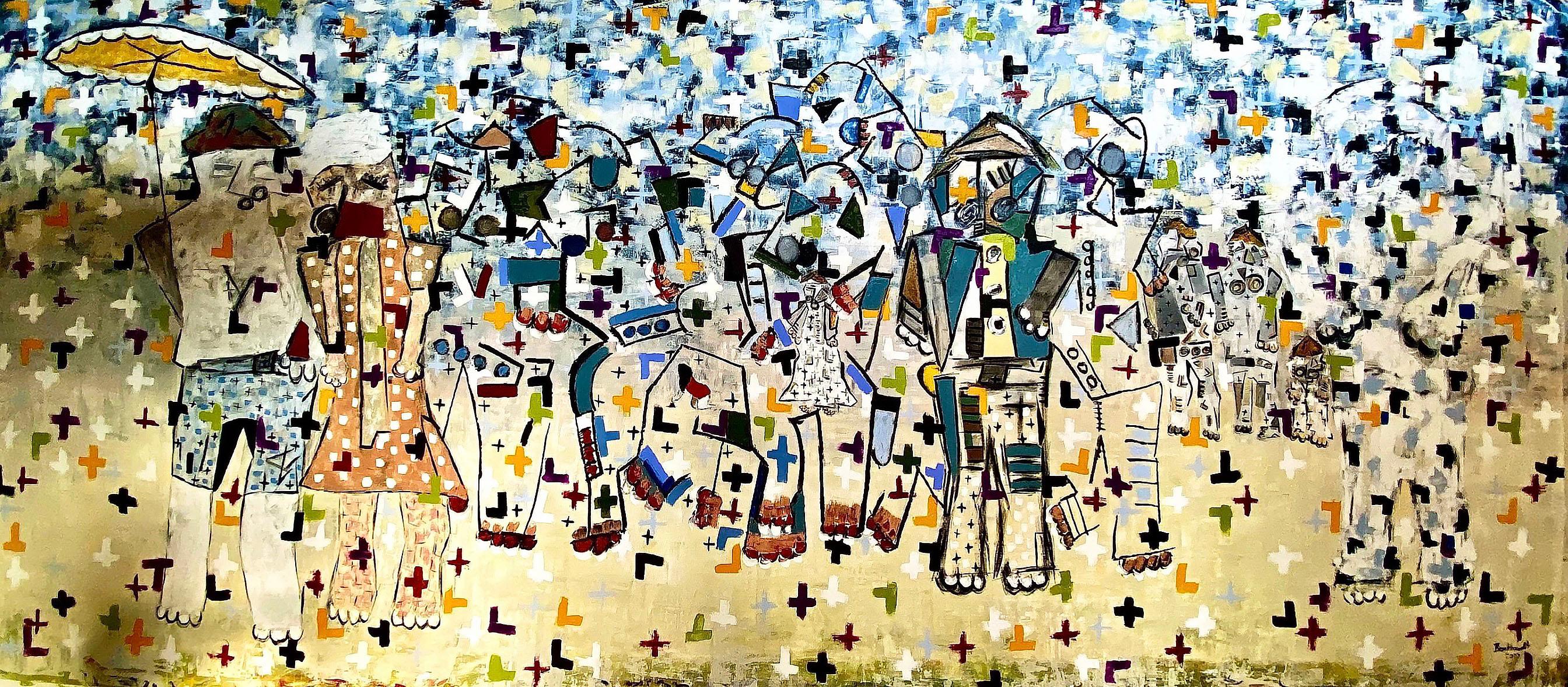Items Similar to Early Abstract 1926 - Scottish Abstract art modernist oil painting
Want more images or videos?
Request additional images or videos from the seller
1 of 20
William JohnstoneEarly Abstract 1926 - Scottish Abstract art modernist oil painting1926
1926
About the Item
Scottish artist William Johnstone OBE painted this stunning abstract oil painting. It is a superb important piece of Scottish Art History and early twentieth century abstraction. An early modernist work, dated 1926 so way ahead of its time and other abstract artists. At the forefront of the Scottish Renaissance and European modernism this painting pre dates the abstraction and Abstract Expressionism of the later mid twentieth century. Earlier than Arshille Gorkuy who was, in the thirties, a bridge between European Modernism and American Abstract Expressionism, Johnstone was inspired and influenced by ideas surrounding the surreal and the subconscious and this painting appears to have elements of this thought process within its key abstract passages.
Signed and dated 1926 verso.
Provenance. William Hardie Ltd, Glasgow label verso.
Condition. Oil on board, 30 inches by 24 inches and in good condition.
Frame. Housed in a black and gold frame, 37 inches by 31 inches and in good condition.
William Johnstone OBE (1897–1981) was a Scottish artist and writer, and was the Principal of Central School of Arts and Crafts from 1947–1960. Johnstone was born in 1897 in Denholm in the Scottish Borders and grew up to a farming family. After the First World War he gave up the life of a farmer to go to Edinburgh College of Art. Here he met the poet Hugh MacDiarmid who shared many of his political and artistic ideals. Together they formed the concept of the Scottish Renaissance to release the nation from its cultural poverty under a centralised British arts scene. Johnstone travelled to Paris in his youth, which opened him to the ideas of modernism. He also spent a large amount of time in the US, where he became interested in Indian cave paintings for their deemed naïve simplicity. During World War II Johnstone became culturally despondent, turning away from practising art to become a teacher, a role which occupied much of his professional life. In 1938 until 1945 he served as the Principal of the Camberwell School of Art and Crafts in London. And later, in 1947, was appointed as Principal of the Central School of Arts and Crafts. Johnstone was noted for his recruitment of a new teaching staff of fine artists which included the painters Mary Kessell (b. 1914) and Richard Hamilton, brought in to assist at the School of Silversmithing and Jewellery. Johnstone played an important and pioneering role in his teaching and promoting of 'Basic Design principles'—which he had developed from his contacts with the Bauhaus- at both the Camberwell and Central Schools. He became well renowned as a teacher, creating innovative courses and employing such important artists to teach as Alan Davie and Eduardo Paolozzi. In 1954 Johnstone's significant contributions to art education saw him awarded an Order of the British Empire. In 1960, Johnstone retired and left the Central School to return home to the Borders to work dually as a farmer and a painter. This was to be his most prolific period as an artist. Johnstone’s work was directly related to modernism, moving away from direct representation to abstraction. Central to his work was the materiality of paint and its formal attributes. This was heavily influenced by the work of the Abstract Expressionists in America. Also, key was the notion of the unconscious, as inspired by Surrealism. Johnstone’s work also took on a very personal relationship with the landscape of his native land of the Scottish borders. In this landscape he saw the tension between humanity and nature. Despite his abstract tendencies, Johnstone’s work still retained a physical sense of the visual world. This is demonstrated in his most celebrated painting A Point in Time 1929–1937 now owned by the National Galleries of Scotland. Johnstone’s work is found in several major UK public collections including the Tate Gallery, the Government Art Collection, The Fleming Collection and the Dundee Art Galleries and Museums Collections.
- Creator:William Johnstone (1897 - 1981, British)
- Creation Year:1926
- Dimensions:Height: 31 in (78.74 cm)Width: 37 in (93.98 cm)Depth: 2 in (5.08 cm)
- Medium:
- Movement & Style:
- Period:
- Condition:
- Gallery Location:London, GB
- Reference Number:1stDibs: LU853113312072
About the Seller
5.0
Platinum Seller
These expertly vetted sellers are 1stDibs' most experienced sellers and are rated highest by our customers.
1stDibs seller since 2018
402 sales on 1stDibs
Typical response time: 1 hour
- ShippingRetrieving quote...Ships From: London, United Kingdom
- Return PolicyA return for this item may be initiated within 14 days of delivery.
More From This SellerView All
- Red Abstract - British 1960 abstract art oil paintingBy Peter L. FieldLocated in London, GBThis vibrant British abstract is by noted artist Peter L Field. Painted circa 1960, the composition in reds has relief sculptural impasto. The red works ...Category
1960s Abstract Abstract Paintings
MaterialsOil
- Surveyed - Contemporary Abstract Art Digital Painting RedBy StanzaLocated in London, GBTo celebrate Stanza's three recent solo exhibitions at HNF in Paderborn Germany 2023, Deutsches Museum 2023 and Samek Art Museum USA we are pleased to present thirty of his works for...Category
2010s Abstract Abstract Paintings
MaterialsCanvas, Oil, Digital
- Scottish Abstract - Exhibited 1965 Abstract Expressionist art oil paintingLocated in London, GBThis very striking exhibited Scottish Abstract oil painting is by influential Scottish artist Jack Knox. Painted in 1964, it is a vivid mix of autumnal colours, textures and brushwork that work perfectly. A brilliant example of his work from the early sixties and which was exhibited at the Royal Scottish Academy in 1965. Titled and dated 21.2.64 lower right. Provenance. Exhibited Royal Scottish Academy, Exhibition 1965, Edinburgh. Condition. Oil on canvas, 51 inches by 36 inches unframed and in good condition. Housed in a gilt sixties surround frame, 53 inches by 38 inches framed and in good condition. Jack Knox RSA (1936-2015) was one of the most influential artists to work in Scotland in the second half of the twentieth century. Born John Knox to a family of tailors in Kirkintilloch, Knox studied at the Glasgow School of Art (1953-57) where his drawings were noted for their mature draughtsmanship. After graduating, Knox went to Paris to attend the atelier of Cubist artist, André L’Hȏte. During his time in Europe Knox digested the various art movements of the moment, including Surrealism, Tachisme, Colour Field and Pop Art. Visiting the great museums, he was particularly interested in Analytic Cubism and Georges Braque’s intimation, rather than description, of object. He also went to Brussels to visit the first major show of American Abstract Expressionism in Europe. He returned to Scotland eager to establish his own style, drawing on everything he had seen in Europe. In 1960 the Glasgow Herald presented an exhibition during the Edinburgh Festival of young artists from the west of Scotland. Knox was selected to show alongside George Devlin, Carole Gibbons, Anda Patterson, Douglas Abercrombie and Duncan...Category
1960s Abstract Abstract Paintings
MaterialsOil
- Red Idol - British 50's art abstract oil painting - Modernist COBRA - provenanceBy William GearLocated in London, GBAn original oil on canvas by the noted Scottish artist William Gear. A fabulous painting. One of his best and a seminal work which dates to 1959. Provenance. Douglas Foulis Art Galle...Category
1950s Abstract Abstract Paintings
MaterialsOil
- Scrambled Messages - Contemporary Abstract Art Digital Painting GreenBy StanzaLocated in London, GBTo celebrate Stanza's three recent solo exhibitions at HNF in Paderborn Germany 2023, Deutsches Museum 2023 and Samek Art Museum USA we are pleased to present thirty of his works for...Category
2010s Abstract Abstract Paintings
MaterialsCanvas, Oil, Digital
- Early Spring - Scottish Abstract Expressionist art landscape oil paintingBy William GearLocated in London, GBAn original oil on canvas by noted Scottish artist William Gear which dates to 1981. Entitled early Spring it is a vibrant and fresh art work with lovely colouring. Signed, dated and titled verso. Provenance. William Gear estate. Royal Birmingham Society of Artists 1981. Condition. Oil on canvas, 48 inches by 32 inches. Excellent condition. William Gear (1915-1997). Few British painters have played an active role in the modern abstract movement of post-war Europe. William Gear was the most passionate and committed exception. He continued the tradition of the Edinburgh-Paris axis established by J.D. Fergusson, Samuel Peploe and others, spending vital years between 1947 and 1950 living and working in Paris. Significantly, in recent years, he received the greatest acclaim in France, Germany and the Netherlands. He was born in 1915 in Methil, Fife, into a mining family; the particular landscape of "pitheads, the sea, rocks, castles, trees, storms and poverty" marked his earliest identity with a place and probably remained the most influential to his art. Years later he recalled as a schoolboy visiting the local art gallery in Kirkcaldy and seeing 12 colourful still-lifes by Peploe. Art-history lessons during student years at Edinburgh College of Art, in particular Byzantine classes under David Talbot Rice, also influenced his concern for structure. This had as much to do with the formal language of painting as sheer delight in the medium itself. Gear never missed an opportunity to show people the merits of a well-constructed painting. On a travelling scholarship in 1937, he chose to study with Fernand Leger, described by Gear as "a keystone for me, seldom abstract, rather a degree of abstraction". The Second World War interrupted these formative years and, by 1940, Gear had joined the Royal Corps of Signals. Dispatched to the Middle East, he still had the discipline to paint - mostly works on paper of damaged landscapes - with exhibitions in Jerusalem, Tel Aviv, Cairo as well as Siena and Florence. His naturally robust and tenacious temperament was profoundly affected by visiting Bergen-Belsen, and this certainly influenced the later experiments with the black armature. As the British officer in Celle, working for the Monuments, Fine Arts and Archives Section of the Control Commission, he focused on securing the safety of the Berlin Art Collection in Schloss Celle, and organised an important series of modern art exhibitions, including the rejected work of Karl Otto Gotz...Category
20th Century Abstract Expressionist Abstract Paintings
MaterialsOil
You May Also Like
- The FamilyLocated in Miami, FLJohannes Boekhoudt is a Dutch artist born on October 20, 1966. In 1973, Boekhoudt immigrated with his parents to Costa Rica, eventually working as a commercial and air ambulance pilo...Category
2010s Abstract Abstract Paintings
MaterialsLinen, Oil
- Uniform Language "Camo" 52 paintingsBy Stephanie PeekLocated in Burlingame, CAStephanie Peek's "Uniform Language" Camo paintings showcasing an assortment of worldwide camouflage (both historic and contemporary) from countries around the world. The complete installation includes 52 original works that are each 10 x 10 inches. Can be hung in an assortment of ways. The artwork comes with a template for installation as shown below. The series started following 9/11 with the bombing of the World Trade Center in NY. and continues to today. Stephanie Peek's "Uniform Language" is a constellation of small painting on alabaster-coated wood panels featuring camouflage patterns of nations worldwide. Peek’s fascination with these patterns stems from her observation of nature (including her studies of flowers, for which the artist is well known), and compositions of shapes and color relationships. When hung in the configuration shown, the overall dimension is 77 inches tall x 132 inches wide. The artwork can hang in a variety of configurations. Each camp painting is 10 x 10 inches. Fascinated by how various countries use camouflage patterns to represent and to disguise themselves and their military equipment, the artist explores how countries see themselves in this pattern language that speaks of power and fear, while also considering each painting a prayer for peace. Artist's statement, Early in the 20th century, the United States military adapted the nature studies of American painter Abbot Thayer...Category
21st Century and Contemporary Abstract Abstract Paintings
MaterialsAlabaster
- EscandaloLocated in Miami, FLJohannes Boekhoudt is a Dutch artist born on October 20, 1966. In 1973, Boekhoudt immigrated with his parents to Costa Rica, eventually working as a commercial and air ambulance pilo...Category
2010s Abstract Abstract Paintings
MaterialsOil, Canvas
- Still Life- Abstract Floral Geometric Contemporary Modern Oil Painting on CanvasLocated in New York, NYMedium Sized Floral Abstract Geometric Oil Painting on Canvas. BIO: Carrie Johnson was born in Kansas City, Missouri, and grew up in the Chicago subur...Category
21st Century and Contemporary Abstract Abstract Paintings
MaterialsCanvas, Oil
- AmistadesLocated in Miami, FLJohannes Boekhoudt is a Dutch artist born on October 20, 1966. In 1973, Boekhoudt immigrated with his parents to Costa Rica, eventually working as a commercial and air ambulance pilo...Category
2010s Abstract Abstract Paintings
MaterialsOil, Linen
- FantasyLocated in Miami, FLJohannes Boekhoudt is a Dutch artist born on October 20, 1966. In 1973, Boekhoudt immigrated with his parents to Costa Rica, eventually working as a commercial and air ambulance pilo...Category
2010s Abstract Abstract Paintings
MaterialsLinen, Oil
Recently Viewed
View AllMore Ways To Browse
Antique Art Collection
Antique Abstract
Scotland Painting
Abstract Jewellery
Oil Painting London Antique
Modernist Art House
Antique Key Art
Early Renaissance Art
Antique Painting Early American
Early Renaissance Painting
Antique European Oil Painting Paintings
Antique European Oil Painting
Antique European Oil Paintings
Scotland Oil
Scottish Oil Paintings
Oil Painting Scotland
American Indian Art Painting
Antique Scottish Art





